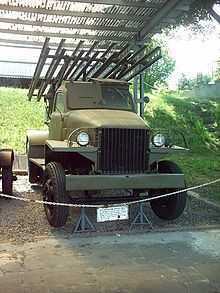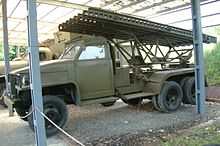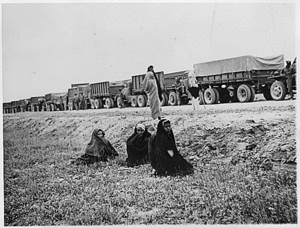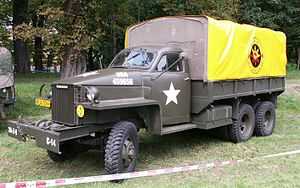Studebaker US6
| Studebaker US6 | |
|---|---|
|
Studebaker US6 | |
| Type | 2 1⁄2 ton (2268kg)[lower-alpha 1] 6x6 cargo truck |
| Place of origin |
|
| Production history | |
| Manufacturer |
Studebaker Corp. REO Motor Car Co. |
| Produced | June 1941-August 1945 |
| Number built | 197,678 (+ 22,204 by REO) |
| Variants | See text |
| Specifications (Cargo with winch[1]) | |
| Weight | 10,485 lb (4,756 kg) empty |
| Length | 265 3⁄16 in (6.74 m) |
| Width | 88 in (2.24 m) |
| Height |
87 in (2.21 m) top of cab 106 1⁄16 in (2.69 m) overall |
|
| |
| Engine |
Hercules JXD 86 hp (64 kW) |
| Transmission | 5 spd. x 2 range trf. case |
| Suspension | Beam axles on leaf springs |
| Fuel capacity | 40 US gal (150 l) |
Operational range | 240 mi (386.2 km) |
| Speed | 45 mph (72 km/h) |
The Studebaker US6 (G630) is a class of 2 1⁄2 ton (2268kg) trucks manufactured by the Studebaker Corporation during World War II, produced in the United States from 1941–1945.
History
In 1940 the US Army set a requirement for a 6x6 truck with a 12 ft (3.66 m) long cargo area and 2 1⁄2 ton (2,268 kg) off-road payload. Studebaker and Yellow Coach (a GM brand) submitted very similar models, with many shared components, while International Harvester submitted its own unique design. All three were accepted and in production by 1941.
Production was divided between Studebaker producing for Lend-Lease, Yellow (later GMC) producing for the US Army, and International Harvester producing for the US Navy & Marines. These three primary manufacturers produced over 900,000 2 1⁄2-ton trucks in all, in both 6x4 and 6x6 axle/wheel versions, with approximately 200,000 Studebaker trucks built in thirteen variations, including dump truck and tractor models.[2]
Specifications
Engine and driveline
The US6 used a Hercules JXD engine, an I6 L-head with 86 hp (64 kW) at 2800rpm and 200 lbf·ft (271 N·m) at 1150rpm. A 4 in (102 mm) bore by 4 1⁄4 in (108 mm) stroke gave 320 cu in (5.2 L) in a conservative and reliable engine. With a compression ratio of only 6:1 it could use very low octane gasoline. This engine was also used in the M3 and later M8/M20 armored cars.
The transmission was a Warner T 93 5 speed with a direct 4th gear and overdrive 5th gear. The transfer case had high and low gears, and engaged the front axle. In 6x4 models it was blocked in high and did not drive the front axle. Both front and rear axles were a Timken split type. The transmission was also used by CCKWs, as were many transfer cases and axles.[2][3]
Chassis
The US6 had a ladder frame with three driven beam axles, the front on semi elliptical leaf springs, the rear tandem on quarter elliptical leaf springs with locating arms. There were two wheelbases, the 157 in (399 cm) long wheelbase (LWB) used in most models, and the 148 in (376 cm) short wheelbase (SWB), used in semi tractors and dump trucks. All models had 7.50-20” tires and dual rear tires. 6x4 models, intended for on road use only, were rated at 5 tons (4536kg), twice the 6x6’s off road rating.[2][3]
Body
The US6 used Studebaker’s civilian truck cab, modified for military use. Studebaker trucks were unique from other 2 1/2 ton trucks built for the war effort because vent windows were included in each door. These windows were separate from the window that rolled down into the door and could be rotated out to help with ventilation.
Studebaker designed the open military cab also used by the CCKW, but their major customer, the U.S.S.R, preferred the closed cab for their climate. While Studebaker's open cab became the US standard, the US6 returned to the closed cab after only 10,000 units.
Models
The US6 series includes the following:
| Model[2] | Description | Wheelbase |
|---|---|---|
| U1 | Cargo with 12 ft (3.7 m) bed | SWB |
| U2 | Cargo with winch | SWB |
| U3 | Cargo with 17 ft (5.2 m) bed | LWB |
| U4 | Cargo with winch | LWB |
| U5 | 750 US gal (2,800 l) tanker | LWB |
| U6 | 5 ton 6x4 Semi tractor | SWB |
| U7 | 5 ton 6x4 Cargo with 17 ft (5.2 m) bed | LWB |
| U8 | 5 ton 6x4 cargo with winch | LWB |
| U9 | Cab and chassis (w/o winch) | LWB |
| U10 | Rear dump | SWB |
| U11 | Rear dump with winch | SWB |
| U12 | Side dump | SWB |
| U13 | Side dump with winch | SWB |
Combat use


Large numbers of Lend-Lease Studebaker trucks were sent into the Soviet Union via the Persian Corridor. The Soviets found them a good platform for "Stalin Organ" Katyusha rocket launchers, although it was not their prime use in the Soviet Union. It fulfilled many roles in the Red Army, such as pulling artillery and was renowned for its ruggedness and reliability. The truck was affectionately known as the Studer by Soviet troops.

Studebaker US6 trucks were also used in the construction of the Burma Road as well as the Alcan Highway in North America.
See also
- G-numbers
- Katyusha rocket launcher
- M35 2½ ton cargo truck
- List of U.S. military vehicles by supply catalog designation
- List of U.S. military vehicles by model number
- Chevrolet G506 trucks
- GMC CCKW
Notes
- ↑ Off-road load rating
References
- ↑ "TM-9-807 2 1⁄2 ton 6x6 Truck and 2 1⁄2 to 5 ton 6x4 truck". US War Dept. 16 December 1943. Retrieved 1 December 2014.
- ↑ 2.0 2.1 2.2 2.3 Doyle, David (2003). Standard catalog of U.S. Military Vehicles. Kraus Publications. p. 122-124. ISBN 0-87349-508-X.
- ↑ 3.0 3.1 Crismon, Fred W (2001). US Military Wheeled Vehicles (3 ed.). Victory WWII Pub. pp. 184, 328–329. ISBN 0-970056-71-0.
- TM 9-1807 "TM-9-1807 Powertrain, Chassis, and Body for Studebaker US6 and US6x4". US War Dept. 17 March 1944. pp. 266, 271, 274, 336. Retrieved 31 December 2014.
- "TM-9-2800-1947 Military Vehicles". US Dept. of the Army. 27 October 1947. pp. 266, 271, 274, 336. Retrieved 31 December 2014.
External links
- Studebaker/Reo US6 2.5 Ton Cargo Truck images and details
- Australian Studebakers US6
- US 2.5-ton 6x6 Trucks in World War II
- Studebaker/Reo US6 at The-Bluprints.com
| ||||||||||||||||||||||||||||||
| Wikimedia Commons has media related to Studebaker US6. |
